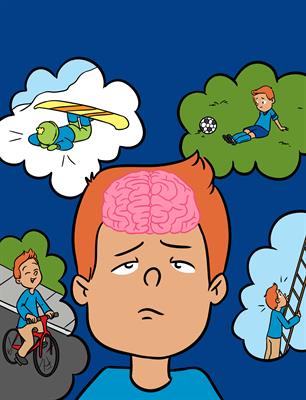
Understanding Traumatic Injury to the Human Brain
Collection Editors
Amy Markowitz, Robert KnightViews
682,206 viewsParticipating Sections
Submission Deadline
Closed
Articles

Neuroscience and Psychology
06/09/2021
How Do You Test a Rat’s Memory?
Authors
David W. Wright
Neuroscience and Psychology
10/02/2021
Tissue Engineering in Traumatic Brain Injuries
Authors
Judy Tanios, Sarah Al-Halabi, Hiba Hasan, Samar Abdelhady...
Neuroscience and Psychology
16/12/2020
What Is Recovery Like After Traumatic Brain...
Authors
Emily L. Morrow, Melissa C. Duff
Neuroscience and Psychology
30/09/2020
Tug of War During Traumatic Brain Injury
Authors
Hiba Hasan, Maha Tabet, Samar Abdelhady, Sarah Halabi, Karl...
Neuroscience and Psychology
30/09/2020
Mitochondria in Brain Injury: Antioxidants to the...
Authors
Maha Tabet, Samar Abdelhady, Nour Shaito, Marya El-Kurdi...
Neuroscience and Psychology
24/04/2020
The Effects of Concussion Can Be Long-Lasting
Authors
Alexandrea Kilgore-Gomez, Hector Arciniega, Marian E...
Neuroscience and Psychology
28/02/2020
Investigating TBI Using Animal Models
Authors
Milin Kurup, Guriel Kim, Lindsey Morrow, Samuel Ruiz, Kevin...
Human Health
28/02/2020
Returning to School After a Concussion
Authors
Melissa McCart, Christina Karns, Meghan Ramirez, Matthew...
Neuroscience and Psychology
17/01/2020
What Do We Learn From Studying Traumatic Brain...
Authors
Kristin Wilmoth, Michael McCrea
Neuroscience and Psychology
14/11/2019
What Happens When You Hit Your Head?
Authors
Janet Y. Le, Sara E. Morgan, Nicole (Nico) Osier
Neuroscience and Psychology
17/07/2019
CTE: The Hidden Risk of Playing Contact Sports
Authors
Hamad Yadikar, Connor Johnson, Edwin Mouhawasse, Milin...
Neuroscience and Psychology
12/04/2019
Sports Are Good for Your Mood, But a Concussion...
Authors
Amanda Clacy, Daniel F. Hermens, Kathryn M. Broadhouse, Jim...
Neuroscience and Psychology
26/02/2019
Studying Brain Injury Through the Blood: The...
Authors
Stephany Kim, Preston Klein, Mindy Nguyen, Nicole Osier
Neuroscience and Psychology
13/02/2019
Preventing the Brain From Being Injured
Authors
Daniela Flores, Sabine Delouche, Gillian Hotz
Neuroscience and Psychology
08/02/2019
How to See Into the Brain Without Surgery!
Authors
Christine L. Mac Donald, Pratik Mukherjee, Esther Yuh
Neuroscience and Psychology
26/09/2016
Why Doesn’t Your Brain Heal Like Your Skin?
Authors
Nina Weishaupt, Angela Zhang
Human Health
13/09/2016
Caring for Your Brain: What You Need to Know...
Authors
Caroline J. Ketcham, Eric E. HallAbout this collection
Your noggin, your noodle, your coconut, your bean! There are many terms for your brain, that fantastic organ that sits inside of your skull, and runs, well, everything, whether you are thinking about it or not. Although the skull is a hard, purpose-built case to protect the brain, we live in an active environment, in which expected events and unexpected accidents may cause what we call a “traumatic brain injury” – everything from concussion on the sport field, to falls from a bike or a ladder or a snowboard, to car accidents and everything in between. These different mechanisms of injury may cause contusions or bruises to the brain, like a bruise to a muscle, and may also result in bleeds in or around the brain, called hemorrhages.All of these types of brain injuries can result in damage to the actual brain tissue as well as cause interruptions to the complex electronic circuitry of the brain, causing symptoms like headaches, dizziness, fuzzy thinking, upset balance, memory loss, and poor sleep, to name just a few. Doctors are very good at treating the acute problems from a brain injury but we currently have no effective treatments for the actual injury to your brain and have to wait and see how the injury resolves on its own. While most people do recover spontaneously, for some, kids and adults alike, the symptoms can persist for a very long time, from months to years and sometimes permanently.
If there is any positive that can come from injuring the brain, it is that sometimes the only way to understand how something works is to “break” it, and watch how it puts itself back to together. In this collection of articles, we’ll study the way we diagnose where and how the brain has been injured, how we treat the acute injury and discuss new models to enhance recovery of brain function. The first steps in our roadmap require a careful assessment of the details of the person’s accident, examining the person thoroughly, and then reviewing special imaging studies called computed tomography (CT) or Magnetic Resonance Imaging (MRI) that show us the structures of the brain, and how they are connected or disconnected following the injury. New blood tests can identify the presence of special biomarkers that indicate that there has been an injury to the brain itself, rather than just to the bony skull. Other important information can come from electroencephalography (EEG), which uses small sensors attached to the skull to capture and measure electronic signals traveling around the brain, to see where the interruptions may be occurring.
We’ll learn about special surgeries, including hemicraniotomy, where the neurosurgeon “pops your top”, sometimes to relieve pressure on the brain, or to stop a hemorrhage from bleeding further, or to insert a protective metal plate. Surgeries and imaging studies give us a great deal of insight about the injured brain, but then what? Studies of other mammals, like rats and mice, can help us, but how, for instance, do we study a rat’s memory? We’ll find out how scientists accomplish this, and see how this knowledge might help patients recover memory after a brain injury.
Importantly, we’ll also learn how can we protect our brains from injury, even when we can’t avoid the accidents that come with everyday life. We’ll explore emerging design of sports helmets and other gear, and learn how a strong neck and back can help prevent injury to the brain and spinal cord.
Would you like to submit to this collection?
For researchers interested in submitting to this Collection, please consult our author guidelines and check that you have all the essentials included before submitting
Editorial Board
Collection Editors
Science Mentors

Amy Altick

Amanda Clacy

Sejal Davla

Aikaterini Dounavi

Benjamin Gold

David Hunt

Vinaya Jaikumar

May Khanna

Michelle Marneweck

Susana Martinez-Conde

Jessie Maxwell

Larisa McLoughlin

Anne Mennen

Unini Odama

Silvia Riva

Jae Kyu Ryu

Eitan Schechtman-Drayman

Marina Shpaner

Amanda Tose

Vinod Venkatraman

Jesse Winer

Robert Wurster

Zhengyi Yang

